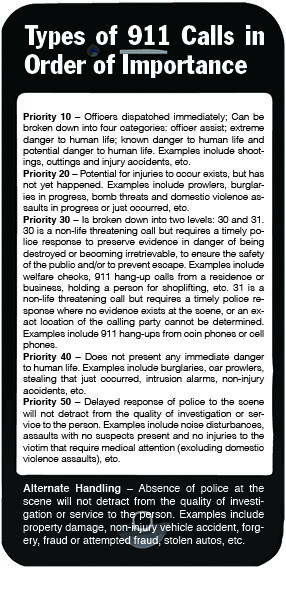By JOSHUA PHILLIPS
Northeast News
January 8, 2014
When danger strikes, the typical move for every Kansas Citian is to pick up the phone, dial 911 and wait until the Kansas City, Mo. Police Department (KCPD) arrives.
However, many residents do not know the exact policies, procedures or number to dial for certain circumstances, said James Schriever, KCPD Community Interaction Officer (CIO) for the Central Patrol Division. While 911 is the number to dial for immediate emergencies, there is also a non-emergency number, (816) 234-5111, that residents can dial.
“Most people in the community do not know about KCPD’s non-emergency number (and the 911 process), which leads to confusion for people,” Schriever said. “Once a situation occurs nearby, a resident will call 911 where a call taker will answer the call for the non-emergency and emergency numbers and ask questions that are pertinent to the call for information to be given to KCPD dispatchers.”
After a call taker gathers information about the 911 call, that information is either sent to the Kansas City, Mo. Fire Department (KCFD) for a fire or ambulance request, or it is sent to a KCPD dispatcher. The dispatcher will send the call information to a KCPD patrol officer located near the scene of the situation who will then arrive at the location. Jeane Rast, staff development supervisor of the KCPD communications unit, said most people do not understand why they are asked questions from the call takers.
“To the person calling police, it feels like forever when they are in an emergency situation,” Rast said. “They (the caller) do not understand the reason why a call taker is asking many questions, but it is to get information for the officer’s safety. We have to verify the address, determine call priority (as well as) if the suspect has a weapon and the suspect’s description.”
For each call, there are certain priorities given that most residents do not understand, Schriever said. For example, if a call is made regarding a shooting or rape in progress, then that call is given top priority over other calls. If a resident calls about a stolen lawn chair or a broken window, then that call has a delayed response or is handled over the phone.
“We aren’t trying to desensitize the crime that is not given a top priority, but people need to understand that some crimes are more important than others,” Schriever said. “If a resident is not sure which number to call and police are needed for the situation, then do not debate if you should call police and just call 911.”
One of the biggest pieces of advice Rast has for people calling 911 is to stay on the line and answer the call taker’s questions, because it “backs up the 911 system when a caller hangs up the phone rather than staying on the line.”
Schriever’s job as a CIO for the Central Patrol Division is to educate the community on procedures and policies of the KCPD as well as serving as a direct liaison from the KCPD to the community he serves. One problem Schriever sees is how Hollywood has influenced residents to believe how police officers should act on duty, compared to the actual policies they have to follow.
“We are constantly under legal and community review and our Chief (Darryl Forté) looks at ways to improve today’s policing,” Schriever said. “How we do our jobs comes down to the legality of it, because the courts mandate us to do something. I think Hollywood has a great influence and television viewers expect officers to do something a certain way like they saw on television.”
Schriever’s biggest piece of advice to Kansas City communities is to utilize the 911 and non-emergency call system, because when the community makes the call, it sends a message out to those who commit the negative activities. When a community does not report criminal activity, then the criminals can continue their negative activity, Schriever said.
Schriever’s goal is to continue bringing awareness of criminal activity to the communities he serves by working hard to educate the community on the 911 process.

















